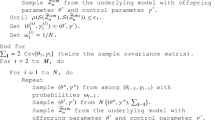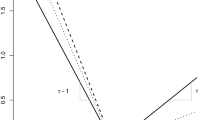Abstract
As stipulated by ICH Q8 R2 (1), prediction of critical process parameters based on process modeling is a part of enhanced, quality by design approach to product development. In this work, we discuss a Bayesian model for the prediction of primary drying phase duration. The model is based on the premise that resistance to dry layer mass transfer is product specific, and is a function of nucleation temperature. The predicted duration of primary drying was experimentally verified on the lab scale lyophilizer. It is suggested that the model be used during scale-up activities in order to minimize trial and error and reduce costs associated with expensive large scale experiments. The proposed approach extends the work of Searles et al. (2) by adding a Bayesian treatment to primary drying modeling.






Similar content being viewed by others
REFERENCES
ICH. ICH harmonised tripartite guideline, pharmaceutical development: Q8(R2). 2009.
Searles JA, Carpenter JF, Randolph TW. The ice nucleation temperature determines the primary drying rate of lyophilization for samples frozen on a temperature-controlled shelf. J Pharm Sci. 2001;90(7):860–71.
Tang X. Evaluation of manometric temperature measurement, a process analytical technology tool for freeze-drying: part I, product temperature measurement. AAPS PharmSciTech. 2006;7(1):E1–9.
Nail SL, Searles JA. Elements of quality by design in development and scale-up of freeze-dried parenterals. BioPharm Int. 2008;21(1):44–52.
Roy ML, Pikal MJ. Process control in freeze drying: determination of the end point of sublimation drying by an electronic moisture sensor. J Parenter Sci Technol. 1989;43(2):60–6.
Rambhatla S, Ramot R, Bhugra C, Pikal MJ. Heat and mass transfer scale-up issues during freeze drying: II. Control and characterization of the degree of supercooling. AAPS PharmSciTech. 2004;5(4):54–62.
Rambhatla S, Pikal MJ. Heat and mass transfer scale-up issues during freeze-drying, I: atypical radiation and the edge vial effect. PharmSciTech. 2003;4(2):1–10.
Cowles M. Review of WinBUGS 1.4. Am Stat. 2004;58(4):330–6.
Kuu WY, Hardwick LM, Akers MJ. Rapid determination of dry layer mass transfer resistance for various pharmaceutical formulations during primary drying using product temperature profiles. Int J Pharm. 2006;313(1–2):99–113.
Pikal MJ, Shah S, Senior D, Lang JE. Physical chemistry of freeze-drying: measurement of sublimation rates for frozen aqueous solutions by a microbalance technique. J Pharm Science. 1983;72(6):635–50.
Pikal MJ. Use of laboratory data in freeze drying process design: heat and mass transfer coefficients and the computer simulation of freeze drying. J Parenter Scie Technol. 1985;39(3):115–39.
Pikal MJ. Freeze Drying. In Swarbrick J, Boylan JC (eds) Encyclopedia of Pharmaceutical Technology.: Marcel Dekker, Inc.; 2002. 1299–1326.
ACKNOWLEDGMENTS
The project was partially supported by FDA grant #HHSF223200811270P, “Study on the development of Quality by Design (QbD) and how this can be applied to the most common parenteral process”.
Author information
Authors and Affiliations
Corresponding author
Additional information
Guest Editors: Lavinia Lewis, Jim Agalloco, Bill Lambert, Russell Madsen, and Mark Staples
The findings and conclusions in this article have not been formally disseminated by the Food and Drug Administration and should not be construed to represent any agency determination or policy.
Appendices
Appendix A—Heat and mass transfer model
Heat transfer through the shelf:
ASV is shelf area per vial. For vials packed as closely as possible \( {\hbox{ASV}} = 1.103 \times {A_v} \). A v is vial area calculated based on outside diameter (cm2), K s is shelf heat transfer coefficient (cal/s/cm2), ΔHs is heat of sublimation of ice (660 cal/g), T s is shelf temperature (K), T f is temperature of the cooling fluid (K),
Heat transfer between shelf and vial bottom:
K cs is constant associated with vial heat transfer coefficient (cal/s/cm2/K), K g is gas heat transfer coefficient (cal/s/cm2/K), T b is temperature at the bottom-center of the frozen layer (K), e s is emissivity of the shelf surface thermal radiation, σ is Stefan–Boltzmann constant, equal to 1.35 × 10−12 (cal/cm2/s/K 4), e v is emissivity of the vial top thermal radiation, T i is the temperature at the sublimation interface (K).
Heat transfer through the frozen layer:
A p is cross-sectional area of the product in the vial (cm2), K I is effective thermal conductivity of the frozen layer (cal/s/cm/K), l max is maximum thickness of the frozen layer (cm), l is thickness of dry layer (cm).
Mass transfer through dry layer:
p i is equilibrium vapor pressure of the subliming ice (Torr), p v is pressure in the vial (Torr), R p is dry layer resistance (Torr h/g).
Mass transfer through stopper:
p c is chamber pressure (Torr), R s is stopper resistance (Torr h/g).
Clausius–Clapeyron equation to determine vapor pressure of ice at sublimation interface:
Stopper resistance, see (11):
S 0, S 1 are stopper mass transfer constants.
Gas heat transfer coefficient, see (11):
K p is constant associated with vial heat transfer coefficient, l v is separation distance of the vial (cm), λ0 is thermal conductivity of gas at ambient temperature, equal to 4.29 × 10−5 (cal/s/K/cm).
Appendix B—Proposed approach
-
1.
Measure nucleation temperature, T n , during freezing, see Fig. 1. Vials should be selected randomly.
-
2.
For these same vials, obtain temperature/time profiles during primary drying.
-
3.
Given the particulars of the vial, stopper, solution, and lyophilizer obtain the necessary heat and transfer model parameters, i.e., vial heat transfer coefficient, vial dimensions, solids concentration, fill size, shelf heat transfer coefficient etc., based on theory or experimentally.
-
4.
Using the primary drying profile obtained in step 2 fit the theoretical model by using Eq. 3 to obtain the resistance parameters for each vial (R 0, A 1, and A 2).
-
5.
Based on theoretical model evaluate the product resistance, R p, during primary drying. We found that evaluation of R p for every minute of primary drying time is a reasonable compromise between speed and precision.
-
6.
Calculate \( \overline {{R_p}} \)(averaged over primary drying duration) for each vial.
-
7.
Use a Bayesian approach to fit an appropriate predictive model (e.g., Eq. 4.) to the experimentally determined data of average resistance, \( \overline {{R_p}} \), versus nucleation temperature, T n (steps 1–6). Obtain ~20,000 draws from the posterior distribution of model parameters (i.e., α, β, and \( {\sigma_{{R_p}}} \)).
-
8.
Obtain the distribution of nucleation temperature, T n , for the target process and the target formulation. Estimate the mean \( \overline {{T_n}} \)and standard deviation \( {\sigma_{{T_n}}} \), and assume a normal distribution (if appropriate).
-
9.
Obtain estimate of average vapor pressure of ice at sublimation interface, \( \overline {{p_i}} \), using theoretical heat and mass transfer model or experimentally. Predict the posterior duration of primary drying as described in Figures 5 and 6.
-
10.
Use the upper percentile of the distribution obtained to estimate primary drying end-point for the target process and the target formulation.
Rights and permissions
About this article
Cite this article
Mockus, L., LeBlond, D., Basu, P.K. et al. A QbD Case Study: Bayesian Prediction of Lyophilization Cycle Parameters. AAPS PharmSciTech 12, 442–448 (2011). https://doi.org/10.1208/s12249-011-9598-x
Received:
Accepted:
Published:
Issue Date:
DOI: https://doi.org/10.1208/s12249-011-9598-x




